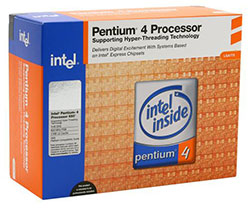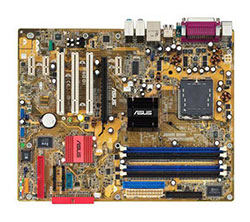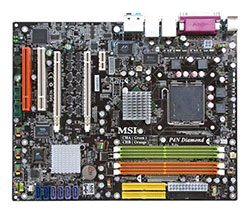Buyer's Guide: Mid-Range to High-End, May 2005
by Jarred Walton on May 23, 2005 5:30 PM EST- Posted in
- Guides
Intel Recommendations
Intel Processors
There are always people who continue to prefer Intel processors for whatever reason. We feel that AMD has the upper hand right now - both in price as well as performance - but there are merits to the Intel platform. We've said it many times before, but let us reiterate that anyone interested in serious 3D gaming should just forget the Intel chips for now. It's really that cut and dry, unfortunately. The dual core Pentium D 8xx parts should also show up at retail any time now, and since multitasking is probably the best argument for Intel enthusiasts, we would seriously recommend waiting for those chips. Those looking to purchase an Intel system now still need to make the decision between 5xx with higher clock speeds and 6xx with more features. (The 5xx chips with EM64T are not yet available either.) In the end, we still can't offer a "one size fits all" choice, so we're declaring it a draw between the two processor lines. You can get a similarly priced 5xx or 6xx chip for both price points, but we're going with 5xx for the Mid-Range and 6xx for the High-End.Intel Mid-Range Recommendation
Processor: Pentium 540J 3.2GHz 1MB (Retail) - Prescott core
Price: $213 Shipped
It's telling that the most reasonably priced CPU from Intel continues to be their 3.2 GHz part. Wasn't the 3.2C originally launched almost two years ago? Anyway, faster Pentium chips are available, but the price scales rapidly. You could even opt for the 3.0 GHz 530J and still get reasonable performance - particularly with overclocking. Although, make sure that you get an appropriate motherboard if you plan on overclocking with an Intel chipset! The 6xx series counterpart to the 540J is the 630, which comes clocked at 3.0 GHz, costs $15 more, and comes with 64-bit support and more cache. If you want to overclock, we'd suggest forgetting 64-bit support and sticking with the 5xx series - doubling the L2 cache does not help with overclocking, needless to say. Still, feel free to try your luck.
Intel High-End Recommendation
Processor: Pentium 650 3.4GHz 2MB (Retail) - Irwindale/Prescott 2M core
Price: $412 Shipped
With the High-End Intel setup, we feel that it only makes sense to grab a 64-bit capable processor. Not everyone is going to need the ability to run XP-64, but if you're going to spend over $400 on a CPU, we think that you're more likely to be part of the bleeding edge who likes to try all the latest and greatest hardware and software. If you disagree or still feel that clock speed is king, the Pentium 560J runs at 3.6 GHz and omits support for EM64T, all while costing $7 (wow!) less. (The 561 should arrive some time in the next couple of months if you're interested in 64-bit support without the 2MB cache.)
The difference between the Mid-Range and High-End Intel processors ends up being just 400 MHz - only 12% to 13% faster in terms of clock speed. Of course, you could also take the CPU recommendation up one more step to the 570J or 660, which would add another $200. (We don't think that it's worth it either.) It's interesting to note that we've had reasonable success running most recent Prescott "J" chips with a 14X multiplier and 1066FSB. All new Pentium 4 processors support EIST, which allows them to reduce the CPU speed and voltages and drop down to 2.8 GHz on an appropriate motherboard. Most enthusiast motherboards allow you to lock the multiplier at 14X and run with the faster bus speed. 3.73GHz ends up outperforming everything including the 570J (due to the increased bus speeds and memory bandwidth, although it's basically a tie) while costing hundreds of dollars less, but nothing is guaranteed with overclocking and some people prefer the guaranteed performance at stock speeds.
Intel Motherboards
The best motherboards for Intel processors pretty much always use Intel chipsets. That may change with the new NVIDIA nForce 4 SLI chipset, but motherboards using the NVIDIA chipset are difficult to find at retail. Furthermore, the new dual core Pentium D processors will require a new chipset to work. That means Intel's 945 and 955 chipsets or the aforementioned nForce 4 SLI for 775. We're still waiting for widespread retail availability (as well as a price drop), which should hopefully come during the next couple of weeks. Newegg and ZipZoomFly (and a few others) have the ASUS P5WD2 (955X) and the MSI P4N Diamond (nF4 SLI), but both cost nearly $250 right now and you still can't find dual core processors. All these factors combined make it difficult to recommend any current socket 775 motherboard, but it's not impossible. There are many good motherboards for both platforms, so just because we don't specifically mention a motherboard, it doesn't mean it's a poor choice. Rather than trying to list the pros and cons of dozens of motherboards, we would suggest that you visit our forums if you want further advice. (Or you can always try emailing us.)Intel Mid-Range Recommendation
Motherboard: ASUS P5GD1
Price: $110 Shipped
There are several things that we're looking for in a decent socket 775 motherboard for a Mid-Range PC. First, we want HD audio and GbE - preferably on the PCIe bus for GbE. We've talked about the difference in price between DDR and DDR2 in the past, but now prices have dropped to the point where that isn't as big of a concern; what's important now is that the board needs to have four memory slots of the same type, since you can't use DDR and DDR2 at the same time. We've never been fans of combo memory designs, as they usually involve a compromise, and that's the case here. Additional features are welcome, but not required, and in the end, we're back to the same ASUS motherboard from our last Mid-Range Guide, albeit with a reduced price. The P5GD1 meets all of the above, and adds in more PATA connectors, good overclocking support, ASUS' proven reliability, and it's still one of the cheaper 775 boards.
The usual suspects are all there with competing products, but they all cost more without offering a whole lot in the way of improved features. The EPoX EP-5EPA+ did well in our roundup, but it's still just a similar product to the ASUS at a higher price. The same goes for the Abit GD8, while the AG8 adds Firewire ports (the only real omission on the ASUS board). The only board that offers something really different from the ASUS is the MSI 915P Neo2 Platinum. It supports DDR2 memory and also has a Firewire connection. Why would you want DDR2 memory? We'll cover this more in the RAM section, but the short answer is that the price/performance for overclocking setups is pretty good.
Intel High-End Recommendation
Motherboard: MSI P4N Diamond
Price: $229 Shipped
Our High-End board is one of the most expensive motherboards that we've ever recommended, and we're giving this recommendation with quite a few caveats. First, we assume that dual core support will work properly (we haven't officially tested it). The bigger factor is that it's one of the few current Intel platform motherboards to support SLI, so if you want Intel and you want the most powerful gaming configuration possible, then you want an nForce 4 SLI board. If you can find a Pentium D to go with this board, our misgivings are not as severe, as certain multitasking tests show that Intel can still beat AMD in that area - particularly when you consider that Pentium D should be available before and cost significantly less than Athlon X2. Just remember that you're spending $70 extra on the motherboard, which certainly cuts into the cost benefits of the platform.
If you want SLI and you don't want to wait for Pentium D to show up at retail, then you're better off with the AMD platform. If you still insist on Intel, that's your right, but most people would say that you're being stubborn. Then again, the cost of a Pentium 4 540J (3.2 GHz) now and a Pentium D 830 (3.0 GHz) later would still be less than the current suggested cost of the cheapest Athlon 64 X2. (My, how the times have changed.) Coupled with the current release schedule - Pentium D should appear at retail several months before Athlon X2 - the High-End, early adopter who demands multitasking performance will probably want to give Intel options some thought. You could always look to SMP workstation setups as well, but then you lose SLI, and that's not something that we want to do for our High-End recommendation.
We should also mention the other SLI option for Intel, the ASUS P5ND2-SLI Deluxe. We've tested that board (along with the P5WD2) and it certainly offers a lot of features. The reason why we didn't recommend it over the MSI board is that it costs an extra $50. Perhaps the MSI board will support DDR2 RAM running at DDR2-1000 speeds and perhaps not. However, most of us don't feel that the additional percentage points gained in performance are worth the increased cost. For gamers, full SLI support is far more important than increased memory speed support.














60 Comments
View All Comments
PotterVilla - Wednesday, December 28, 2005 - link
Hello,I've not been able to find a XFX, MSI, or eVGA 6800GT graphics card at new egg (I'm not really looking to buy, just being wishful) and I also saw that the 6800XT is only $170. The 7800GT is more in your ballpark of $345 a card. Would ether of these cards be an upgrade, and has their price gone down that much ($175) in only about seven months?
Thank you.
jonp - Friday, August 26, 2005 - link
i wonder about the hp 1905fp recommend for the mid-range non-gaming display. there are considerable comments here and elsewhere about the poor analog (d-sub 15 pin) performance ie image quality. the Genesis gm-5321 controller chip is no longer shown on their web site and the datasheets are no longer available as well. (one wonders how much longer the 1905fp will even be available?) the dvi interface might be great, but there are some of us who connect their display through a kvm that only handles analog signals--so dvi performance is of little interest. i think we need a new monitor review and new pick for the non-gaming monitor recommendation. we depend on Anandtech for solid testing and non-subjective analysis to guide us in our quest for the best value. it is clear that we need new help in this area.JarredWalton - Thursday, June 16, 2005 - link
56 - not usually on NVIDIA nF3/4 or Intel chipsets. That's only an issue with secondary SATA controllers (VIA, SiS, Silicon Image, etc.) But still, never hurts to have that $8 part around just in case!mhallang - Wednesday, June 15, 2005 - link
Another reason to get a floppy drive is to install Win XP on a SATA drive. Maybe SP2 is different, and I would bet there's another way around it; but my experience was that I needed a floppy with the SATA drivers during the install process for XP.JarredWalton - Monday, June 13, 2005 - link
54 - Oh, I'd stay far away from XP64 for SLI. Raw doesn't begin to describe it, IMO. Longhorn is when I'll actually consider switching to a 64-bit OS.GreedyBumps - Thursday, June 9, 2005 - link
I built this system with all major components that are in this guide and cannot get SLI to work. Both cards work great individually but when I try to but them both in in SLI mode screen goes black after the black windows loading screen. I have tried all the driver / bios updates for everything I could find and still no dice.One issue could be that I installed Windows x64 professional - maybe some drivers are still too raw.
Also - the SLI jumpers on this DFI Lanparty board are a complete pain. They are tough to pull out and there are 6 of them. When you are trying to get SLI to work it is absolute nightmare to keep switching between SLI and Normal jumper cable settings.
JarredWalton - Wednesday, June 1, 2005 - link
52 - I got the information from Wesley. Basically, there is a higher number of RMA for motherboards and RAM when voltages above 3.3V are used. (Not too surprising, really, as higher V = higher heat.) 3.3V and below are fine, but there is a jumper to allow up to 4.0V. If you use that jumper, it causes problems. That's my understanding. In other words, don't plan on running OCZ VX at 3.7V with no active cooling. :)hgkfahgsa - Wednesday, June 1, 2005 - link
Jarred, could you elaborate on the problems with high voltages with the DFI cards? Is there any chance of the problems being resolved, does 3.3 volts work? etc... Thanks.JarredWalton - Friday, May 27, 2005 - link
50 - I know there are some Turtle Beach cards with S/PDIF in and out connections. M-Audio also has some, i.e. the Delta and Audiophile. Which one you want depends on the use. Most only have optical *OR* coaxial (RCA). I think many of the models with external boxes have both. If you were interested in an expensive, "everything" solution, there's the Audigy 4 Pro, but that's $280 or so, and I can't vouch for the actual quality as a whole.Honestly, I'm not a demanding audio person. If you want more advice on audio, I'm sure there are people in our forums that can provide better advice for "pro level" cards. You may as well ask me for advice on cars while you're at it! (Get something cheap and reliable!) ;-)
devslash - Friday, May 27, 2005 - link
how important is capability of S/PDIF input. i dont see many motherboards that have this on-board.isn't it important/good to have it, so DVD's audio
can be directly fed into the on-board sound system?
can you recommend a good board w/ S/PDIF input?